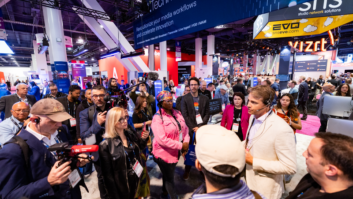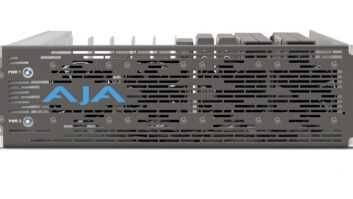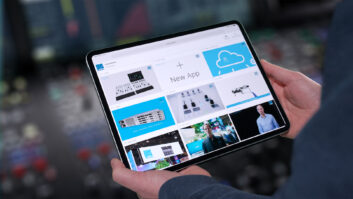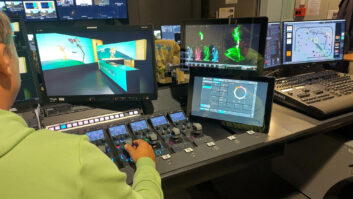Paul Turner, director of product management, AJA Video Systems
Familiar themes, SMPTE ST 2110 and HDR, drove many conversations in the M&E industry in 2024. SMPTE ST 2110 video emerged into the limelight, with the cost of network switches dropping and the pool of available IT video engineers growing steadily. More broadcast and production teams felt confident tapping into the IP protocol to transport uncompressed video over IP across select parts of the production chain. Experimentation primarily took place in sandbox environments, with many facilities opting for a hybrid SDI/SMPTE ST 2110 approach. A significant development, this spike in adoption speaks volumes about the growing industry demand for improved operational and cost efficiency when transporting video across facilities.
SMPTE ST 2110 is changing the game for M&E professionals because of the massive volume of uncompressed video it allows them to get across a single 25 GigE SMPTE ST 2110 cable; you can transport a couple of 4K/UltraHD or a significant number of HD signals. Its bi-directional nature is also convenient in that you can send signals back and forth between multiple destinations, all while decreasing rack space and reducing power consumption.
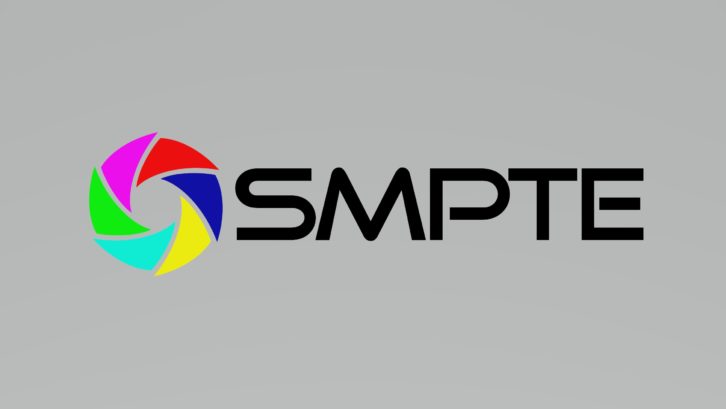
Colour consistency is crucial from content creation through consumption, making discussion around colour management hard to escape this past year. What became apparent is that professionals need to give more consideration to colour pipelines in pre-production. For the industry to fully capitalise on the benefits of HDR, it must be the first consideration instead of an afterthought, and many professionals have begun to recognise this. To this end, we saw more facilities and professionals dig deeper into colour management and conversion tools and educate themselves, which we anticipate we’ll see more of in 2025.
In 2025, it’s reasonable to assume that technology developers will release more tools that bridge current SMPTE ST 2110 pipeline gaps. As they do, SMPTE ST 2110 adoption will grow among broadcasters and production facilities. Out of this development, we may just see a new class of engineers who understand both video and IT. And as the industry’s collective knowledge base expands, more training and educational resources will likely become available, making SMTPE ST 2110 more accessible.
All that said, SDI isn’t going away any time soon, and most SMPTE ST 2110 adoption we see in 2025 will be in hybrid implementations, albeit greenfield projects. This is why conversion technology that allows teams to move audio and video seamlessly between baseband SDI and SMPTE ST 2110 devices will be a crucial part of many IP strategies in the coming year.
Andy Rayner, CTO, Appear
In 2024, the uptake of remote and distributed production were gamechangers, this technology architecture enabling live broadcasts to be run from anywhere with fewer resources and lower costs. This shift not only enables smaller, lower revenue generating events to use multi-camera setups but also reduces the environmental footprint of live productions by cutting down on travel and equipment transport. At the same time, real-time, data-enriched viewing experiences, such as AI-driven analytics and personalised camera feeds, is transforming how audiences are able to interact with live content. These trends show a clear move towards more efficient, scalable, and sustainable production models.
Real-time data and personalised options are turning passive viewers into active participants, keeping them more engaged while opening new revenue streams. By helping sports production teams to do more with less, distributed production helps broadcasters lower costs and emissions by reducing the need for large on-site crews and trucks. This in turn is making multicamera production viable for lower tier sports and events. Advanced compression technology further supports sustainability by enabling high-quality production with less bandwidth and power consumption.
In 2025, hybrid cloud workflows will take centre stage, combining the flexibility of cloud computing with the control of on-premises systems to support more efficient and sustainable production. AI will play an ever-increasing role in automating tasks like highlight creation and predictive analytics, making production faster and less resource intensive. Broadcasters will also focus on making systems interoperable and more secure while delivering even richer, more interactive content. Sustainability will remain a key focus (at least in some global areas), with energy-efficient tools and smarter workflows driving down environmental impact.
Distributed (location agnostic) production will continue to grow, with more demand for flexibility in how live events are produced. Broadcasters will need tools that work across both on-premises and cloud environments, letting them scale up or down easily. The Appear APX solutions suite will grow throughout 2025 and the following years to facilitate ever increasing flexibility and ease of deployment.
David Isola, director of global product marketing at Black Box
Industry trends standing out in 2024 were the ongoing shift to IP-based production workflows, i.e., the transition from SDI to IP. The key learning here is that IP-based systems provide greater flexibility and scalability, they’re more dynamic, remote, and they allow for more decentralised workflows. IP-based systems are creating an avenue for broadcasters to move away from costly, dedicated broadcast hardware into more flexible, software-defined environments, resulting in reduced equipment and maintenance overhead costs. Some have even said that IP technology is able to dominate future broadcast workflows – particularly with the growing demand for cloud-based and remote production capabilities.
SDI requires dedicated infrastructure such as coaxial cables, SDI compatible devices, etc. SDI signals can degrade over long distances, and scalability can be costly. IP broadcasting utilises IP network infrastructure such as switches, routers, CATx cabling for transmitting, producing, and distributing AV content in the broadcasting environment. IP is flexible, cost effective, and the bandwidth flexibility of IP networks allows for efficient transport and processing of high-resolution video. By minimising the reliance on proprietary hardware (such as SDI) IP systems can significantly reduce initial and ongoing costs.

Throughout the new year, as the transition from SDI to IP continues, this will further develop into further cost savings and increases in collaborative flexibility, which has opened the door for IP-based news, sports and other live productions. This shift has already and will continue to influence broadcast workflows by providing access to media assets, editing tools, and playout systems from anywhere in the world – all of which can now be managed remotely. IP is an open standard, making it extremely versatile and available to be used in almost every type of network including LANs, WANs, and the internet plus the added benefits of seamless integration with IT tools. This will continue to give broadcasters the ability to adapt to future advancements with ease. Other trends will continue to evolve in broadcast. These include 5G, VR/AR, SDI to IP and the continuation of digital transformation, we also can’t overlook ever changing user demands.
Stuart Ashton, director, Blackmagic Design
One of the key trends in 2024 was the growing acceptance and integration of the cloud into workflows, with lots of testing and proofing throughout the media and entertainment industry. While budgets tighten, quality expectations remain higher than ever. Productions are under pressure to do more with less. Technology like Blackmagic Cloud is stepping in to speed collaboration – allowing disparate teams to work effectively in real-time rather than relying on slower media transfer or back-and-forth workflows between post-teams or facilities.
At the same time, IP adoption is on the rise. A significant driver is the move to remote-based and decentralised workflows as the industry looks to implement more sustainable practices while achieving cost savings and efficiencies. The shift from SDI to IP is gradually transforming how content is handled in broadcast and live production. Although there are still challenges related to cost and network infrastructure, IP is gaining momentum.
These trends are leading to a more efficient and connected production environment. The shift to cloud-based workflows is flattening the traditional linear structure of post-production, making processes like editing, grading, and visual effects more collaborative. Different creative roles can work simultaneously, while production teams can start colour grading or refining visual effects before picture lock, resulting in better creative outcomes and more adaptable workflows.
There is also increased awareness of how IP can address the challenges of traditional infrastructure in live and broadcast settings. By making media transport more flexible, IP 2110 offers the scalability that modern productions need. IP-based workflows also enable more flexible and remote production setups by decoupling media transport from traditional cabling. While SDI has been the de facto standard for years, the move to IP, despite some initial concerns about cost and complexity, offers the scalability and flexibility that modern productions need.
Looking ahead for 2025, we expect the adoption of Cloud and IP-based workflows to keep accelerating, driven by the need for greater efficiency and the rising demand for creative flexibility. In broadcasting, we can expect more progress toward standardising IP technologies, which will be crucial for broader adoption. To achieve this, it’s essential that, as an industry, we continue working towards practical solutions that make IP adoption more accessible while continuing to reduce cost and complexity.
As more manufacturers align with common standards and network costs decrease, using IP should become as seamless as using SDI, helping those across the media and entertainment sector implement scalable, future-proof workflows.
Dave MacKinnon, vice president of product management, Clear-Com
One of the biggest trends last year was the continued growth of remote and hybrid production workflows. We’ve seen broadcasters and production companies really embrace IP-based communication tools to connect teams across different locations seamlessly. Sustainability is another trend that’s gained a lot of traction—there’s a noticeable push for greener production practices, from energy-efficient equipment to cutting down on travel. Clear-Com has embraced both of these with new products that address the move to more flexible productions as well as manufacturing out products in California, where sustainability is the norm.
These trends are fundamentally reshaping how the industry operates. Remote workflows have made productions more flexible and scalable, allowing teams to collaborate globally in ways that would’ve been unimaginable a few years ago. Sustainability efforts are driving real change in how we think about the lifecycle of equipment and energy use, which is great to see. M&E companies are trending towards a more “occasional” workforce for production roles. Daily hires can be working in studio production one day and then bounce to field production another day. That means we have to have intuitive interfaces for our products and flexible back-end infrastructure to handle the changing landscape of the business.
In 2025, I think we’ll see remote production workflows evolve even further, with cloud-based tools becoming more of an industry standard for collaboration. Connectivity improvements will make it easier to handle complex productions from virtually anywhere. On the sustainability side, I expect more companies committing to long-term green initiatives that make business sense. Efficiency in the M&E industry means that you can’t just have infrastructure and resources sitting around. You want to maximise the usefulness as much as possible. Same for sustainability. Nobody is doing it just to “look cool” anymore; green initiatives have to make financial sense. For us at Clear-Com we have a suite of products in development that take advantage of these trends that add to our broad set of capabilities already in the field. We’re excited about what’s coming.

One trend I’m keeping an eye on is the need for better interoperability between communication systems. As productions get bigger and involve more players, having equipment from different manufacturers work seamlessly together will be a major priority. I also think we’ll see immersive technologies gain more traction, especially in live events, where audiences are craving new ways to connect with the content. And as IP workflows continue to expand, cybersecurity is going to become an even bigger focus to protect those critical systems. The bottom line is that products in the M&E space need to become smarter, cheaper, and faster.
Kevin Fernandes, CRO at Dejero
Last year brought a rapid acceleration of cloud adoption in broadcast and OTT organisations. It’s common knowledge that cloud platforms save on big investments on hardware and infrastructure, but not only that, they enable broadcasters to quickly scale their resources to accommodate sudden spikes in demand, like live events or breaking news coverage.
Cloud-based tools have changed the game for remote production workflows, allowing teams to collaborate and produce content from anywhere in the world. Many of Dejero’s customers – in particular live sport production companies – are using all-remote models, whereby crews only need to take cameras and mobile transmitters to a sports venue or multiple sports venues. This means that producers, directors, graphics operators and technicians remain in the hub – to package content for distribution from the hub – which could be located on a different continent to the sports venue/s.
Cloud platforms provide a gateway to accessing AI and machine learning tools, so that broadcasters can automate tasks, improve content personalisation, and enhance audience engagement. AI is probably the most significant trend of 2024, but without real-time connectivity, AI tools and analytics cannot be accessed.
The cloud has been transformative, because it has allowed smaller players and new entrants to the market to grow really fast, without having the baggage of the big broadcasters. The cloud is addressing the needs of the prosumer to increase the power they have to build audiences, opening up new opportunities as professional broadcasters/individuals.
As we head into the new year, we see traditional news channels are disbursing, and influencers are on the rise. The internet and social media have fundamentally changed how people consume news. Modern audiences are increasingly fragmented, with niche interests and diverse preferences. The decline in traditional advertising revenue has also impacted the financial sustainability of news organisations, so prioritising cloud, digital platforms and AI, and producing high-quality, relevant, and engaging content is key.
AI is helping with content creation and curation. It can generate news articles on routine events, such as sports scores, financial reports, and weather updates, freeing up journalists to focus on more complex stories. AI algorithms also analyse vast amounts of data to identify relevant news stories, trends, and potential angles, helping journalists prioritise their work and tailor news content to individual preferences, increasing audience engagement and loyalty.
We’ll see more virtualisation in the next 12 months. It gives broadcasters and OTT platforms the flexibility to be able to quickly deploy new services and applications, and to spin-up and spin-down new channels or online platforms, without the need for significant hardware investments or lengthy setup times. This easy scaling of resources accommodates fluctuating workloads, such as live events or peak viewing or seasonal periods.
5G and Edge computing will also have an even bigger presence in 2025. 5G networks will continue to expand – providing low-latency streaming of high-quality video content and potentially serving AR and VR experiences to a wide range of devices. Edge computing, that effectively processes data closer to the source, also reduces latency, making for smoother video streaming, reduced buffering, and an overall better viewer experience. It also enables faster recovery from outages, as data can be processed and delivered locally, so that broadcasters don’t have to rely on centralised data centres.
Fabio Varolo, sales manager, FOR-A Europe
The most significant trend last year was the industry’s cautious but steady progression towards IP infrastructure, though traditional broadcasters are taking a measured approach to this transition. We’re seeing a fascinating dichotomy where newer entrants are embracing IP-based workflows while established broadcasters maintain hybrid SDI/IP environments, demonstrating the industry’s practical approach to technological evolution.
This measured transition is driving the development of more flexible, software-defined architectures that can bridge traditional SDI and IP workflows, allowing broadcasters to evolve at their own pace. The focus has shifted towards solutions that enable smooth transitions rather than wholesale infrastructure changes, particularly as broadcasters carefully manage their technology investments in the current economic climate.

While technologies like SMPTE ST 2110, HDR, and remote production capabilities continue to mature throughout 2025, I expect we’ll see more emphasis on practical implementations that deliver immediate operational benefits rather than wholesale infrastructure changes. The key development will be in solutions that help broadcasters maximise their existing investments while preparing for future IP transitions.
This year, rather than entirely new trends emerging, I anticipate we’ll see a more pragmatic evolution of existing technologies, with particular focus on software-defined solutions that can adapt to both traditional and IP-based workflows. The emphasis will be on helping broadcasters find cost-effective ways to enhance their capabilities while maintaining reliable operations, especially in areas like remote production and resource sharing across multiple locations.
Steve Reynolds, CEO of Imagine Communications
Because last year was such a banner year for sports, one stand-out trend was the accelerated move toward remote and cloud-based production thanks to SMPTE ST 2110 and the native IP protocols used for contribution to cloud. One example is the synthesis between 2110 and JPEG XS — basically native IP speaking to native IP via VSF TR-07 and TR-08 — which was proven at the Paris Games. We’ve also seen extensive use of H.264 via SRT in cases where the cost vs. bandwidth trade-off favours higher compression.
A more surprising trend was how media companies — even digital natives — rediscovered linear as a way to drive ROI and TCO. Here too there’s a connection to live sports, with one high-profile U.S. example being Amazon’s live streaming of NFL Thursday Night Football, which they paired with linear ad sales. This strategy demonstrates the enduring value of linear TV in reaching broad audiences and driving monetisation.
The impact of ST 2110 and JPEG XS has been significant in live sports production, enabling broadcasters to more efficiently transport high-quality video with low latency, streamline workflows and enhance scalability. Additionally, JPEG XS shines in its ability to provide an on-ramp to the cloud, bridging traditional production setups with advanced cloud-based operations. This approach supports real-time collaboration, faster delivery, and superior content quality, vital for large-scale events.
When it comes to the industry’s renewed focus on linear, the impact is two-fold: By integrating digital streaming with linear ads, broadcasters tap into a hybrid model that enables them to engage diverse viewers, while leveraging well-established revenue streams. Enabling digital to be sold like linear — with broadcast-quality rules and brand protection — strengthens customers’ ability to sell inventory in a direct but automated way, which is the key to maximising streaming revenue.
In 2025, sports broadcasting will continue to be a battleground between established broadcasters and digital newcomers. Broadcasters who are sports rights holders are all looking for ways to move more of that live sports content into their CTV and live streaming channels. If they’ve already deployed IP production infrastructure, then the fastest, easiest, most affordable way to make that move is to use JPEG XS as the on-ramp.
The market’s focus on the revenue-driving advantages of linear will continue to develop in 2025, especially when the goal is to reach large audiences simultaneously. With emerging ad tech innovations, it is possible for big brands to purchase ads that guarantee category exclusivity during a commercial break in the digital environment — something that was previously limited to linear TV. The future of advertising lies in integrating the best of each platform, optimising the user experience while maximising returns for advertisers.
With no Olympics or elections driving advertising revenue in 2025, it will likely be a challenging year for the media industry, so reducing costs will be a top priority. One of the ways broadcasters will navigate the challenge is to do the maths to determine whether it’s more cost-effective to run their operations on-prem or in the cloud. For example, if you’re deploying a disaster recovery solution or operating FAST channels that are never going to touch an antenna, it’s probably cheaper to do it in the cloud. But if you’re running 24/7/365 workflows or have significant investments in studios, IT teams, HVAC systems, and backup generators, on-prem solutions may make better economic sense.
As we head into 2025, broadcasters will increasingly do the TCO maths to determine whether on-prem, cloud, or a hybrid of both will best meet their unique needs and budgets in a challenging economic year.
Anupama Anantharaman, vice president of product management, Interra Systems
The media industry has been increasingly focused on maximising efficiency through advanced automation and intelligence technologies. AI and machine learning (ML) are certainly standing out as promising technologies, and have begun to penetrate all aspects of the content lifespan, handling complex processes in production, video processing, localisation and delivery. In addition, these technologies are helping enhance decision-making and the personalisation of viewer experiences. We are also seeing consumers having higher expectations, both in terms of content quality and variety from video service providers. They are increasingly demanding flawless streaming experiences complete with high-quality video, no buffering, and personalised content on any device.
To meet these demands, media companies are working hard to simplify their workflows, aiming to improve video quality while cutting bandwidth costs. They’re turning to newer video compression methods, cloud technologies, and AI tools to strike the right balance between delivering exceptional experiences and managing expenses. This effort highlights how critical it has become for the industry to align with the high standards set by modern audiences. However, with these advancements, the need for precise monitoring has likewise intensified. Managing diverse formats and variants across workflows now relies on cutting-edge diagnostics, real-time analytics, and rigorous quality control at every stage, ensuring seamless and efficient operations in an increasingly competitive landscape.
The adoption of AI-driven tools has significantly impacted the media and entertainment industry, enhancing production quality and streamlining operations. With AI, media companies are empowered to deliver higher-quality content across an expanding array of platforms. This shift is pivotal in engaging and retaining audiences, especially within the competitive streaming sector. These innovations are not only enriching the viewing experience but also ensuring content reaches and resonates with a more diverse global audience.

The sophisticated application of metadata promises to enhance the speed and efficiency of live productions significantly. Additionally, the role of augmented and assistive AI and ML is expected to become more targeted, with media organisations clearly identifying their optimal use cases and implementation points. Localisation stands out as a key area of impact, where advanced tools and systems for generating and managing ancillary data related to audio and video are increasingly being adopted to streamline operations. However, it’s clear that these technologies are still evolving when it comes to delivering consistent accuracy and reliability. These tools will need further refinement to handle complex tasks effectively, and their performance across different workflows isn’t yet guaranteed.
In 2025, we can expect broadcasters to adopt all-IP infrastructure in an effort to modernise their facilities for next-generation content delivery. The industry is also likely to see broader adoption of more efficient compression standards such as AV1, alongside the increasing prevalence of 4K video.
Emphasis is expected to shift further toward cloud-native infrastructures, advanced low-latency technologies, and streamlined approaches to maintaining exceptional streaming quality. Media companies will also likely increasingly adopt AI-driven solutions for personalisation, content classification, real-time analytics, and automated quality control — particularly when these technologies offer cost advantages or a competitive edge.
Ronen Artman, VP of marketing. LiveU
In 2024, the broadcast industry underwent significant transformations, with notable trends including a shift to digital platforms and technological innovations such as AI and 5G. Among these, the adoption of remote production (REMI) workflows stood out for us, enabling broadcasters to cover events from virtually any location. Advancements in IP-based technologies and cloud-based services facilitated seamless collaboration across distances, making remote production solutions the standard for covering high-profile events like the Summer Games, Euro 2024, and the European Athletics Championships. This approach enhanced flexibility, efficiency, and profitability by reducing the need for on-site personnel and leveraging cloud-based workflows.
These trends have enhanced content creation, delivery and user engagement. AI enhances content creation and provides deep insights into audience behaviours while 5G improves content delivery with high-speed, low-latency, enabling seamless streaming of high-definition content and supporting immersive technologies. The adoption of remote production has increased operational efficiency by up to 70 per cent, allowing broadcasters to manage multiple events remotely and adapt to changing circumstances. Together, these advancements enriched consumer experiences through personalised, high-quality, and interactive content, while enabling the industry to operate more efficiently and flexibly.
In 2025, the media and entertainment industry is set to deepen its digital transformation, with AI and 5G technologies enhancing personalised content delivery and enabling innovative formats like interactive and immersive experiences.
We will see an increase of hybrid and lightweight production models, combining cloud, remote production technologies and on-site elements to ensure efficiency from a cost, time, effort and sustainability standpoint.
Rupert Watson, senior director of sales, LucidLink
Last year saw an emphasis on cost saving; the move to OpEx and large organisations starting genuinely be cloud first.
The pioneers are starting to move to new models; the old and slow are not and will wither on the vine.
Throughout 2025, once the efficiencies and cost savings start to accrue, those that adopted earlier will be seen to have benefitted more.
There will be an increased realisation of the professionalism of content creators on YouTube and their inclusion into the mainstream of M&E industry events. The older generation of production and post have been a bit stand-offish about them, but that will change in 2025.
Fabrice Maquignon, CEO, Mediagenix
The media and entertainment industry saw a lot of change and innovation over the last 12 months. Among the stand-out trends has been the momentum behind data-driven strategies. It’s no exaggeration to say that the deeper integration of data into strategic thinking and operational processes is helping to reshape the M&E landscape, empowering organisations to significantly improve efficiency and effectiveness across a range of areas. Whether the technology is applied to areas such as ratings prediction, schedule optimisation, content discovery or scalability, the improved use of data is making a positive impact, including the scope it offers for freeing up human resources to focus on strategic and creative priorities.
Looking at creativity more closely, the industry is arriving at a point where creativity is being enhanced by deeper data-led insight. For example, a structured brief that is informed by data allows creators to focus their time and effort rather than working in an unguided environment. At the same time, however, organisations must ensure they don’t become over-reliant on data and models because there is a risk it will actually stifle creativity. This is a very important balance to strike.
Being data-driven is giving the industry new ways to address both efficiency and innovation. Looking at business processes, for example, by drawing on the insight that data can bring, businesses can eliminate bottlenecks and make quicker, more informed decisions. This can deliver the kind of organisational agility leaders are looking for to adapt to audience demands and take advantage of new opportunities. It also allows M&E businesses to be more audience-centric because they can more easily and accurately learn from real-time feedback and continuously improve their strategies.
In relation to creativity, organisations are working hard to balance data-driven insights about issues such as audience behaviour and viewing preferences with the proven benefits of creative experimentation, intuition and gut feel. In this context, thinking outside the box remains a valuable way to deliver success and underlines the point that creativity is the foundation for the industry as a whole.
Throughout 2025, it’s likely that M&E organisations will continue to focus on how to improve their use of data-led insights in areas such as audience engagement. This process will help them refine decision-making and improve audience targeting, ensuring content aligns more closely with changing viewer preferences. Data will also be used by to build a more unified view of all of their content assets and rights so they can embrace the opportunities presented by trends such as micro-segmentation and maximise content RoI. In this context, we’re also likely to see the industry focus more heavily on specific niche audience groups. This will enable them to tailor content and advertising opportunities with increasing precision, which will have a positive knock-on effect on regional growth and bottom-line success.
We’ll also see more evidence of how data can positively influence creative processes, what content providers can learn from real-time insight and who does the best job of balancing data-led decision-making with human creativity.
Rajesh Patel, VP sales and solutions EMEA at Mediaproxy
AI has been the top talking point for many people, although there is still much confusion around the topic. Many believe that it can solve a whole range of issues, but really need to look deeply at what they are trying to achieve. Refining AI processes and training take time and effort.
Cloud is still a hot topic, as media companies dig deeper into the benefits and disadvantages. Those will be different for every user: there is certainly no single answer. Like other smart vendors, at Mediaproxy our architecture supports processing and integration at the microservices level, so users are free to decide for themselves how they create their own architectures.
On a more general level, the idea of pop-up channels is gaining momentum. Viewers crave live television, but event rights are expensive and one way to control costs is to spool up one or more channels around events as required.

The biggest brake on widespread use of the cloud for media applications is the charging structure, which is really not designed for our small number of large files model. For our part, we work with the major cloud providers to define the best way to deploy our compliance tools.
The over-riding goal of all media companies, now and in the immediate future, is to drive down costs. As linear channels become less important to viewing audiences, so the whole business model of advertising-funded television has to change, centred on optimising efficiency, and that will determine technology choices.
That is why enthusiasm for the cloud has tempered: media companies need first to define their best possible workflows, then find the technology which can support them cost-effectively. How can AI boost productivity and empower new services without compromising quality? Do you already have the AI you need, in your asset management or workflow automation? Do you need to invest in more tools?
This year, the focus will be solely on boosting revenues and controlling costs. Pop-up channels will become more important, and broadcasters will want the resources to implement them.
That means scalability in back-office tools, and automation across the whole process. Widespread workflow automation reduces the possibilities of error as well as controlling operational costs. Media companies will expect vendors to provide technology which is readily integrated, with open APIs and standards compatibility, so they can create precisely the workflows they need, whether that is on premises, in the cloud or as a complex remote hybrid.
Jonathan Smith, solution area expert, cloud, Net Insight
Last year, I saw a general acceptance across the industry that producing and distributing content in a traditional way is not sustainable for the changing consumer market. The tech conversations have changed from innovations in cloud-based and IP workflows that mimic the traditional broadcast approach to looking at how to engage a completely new consumer need. The sports broadcasting industry, in particular, has been evolving to find new ways to engage with increasingly global fanbases to capture more viewers and lengthen viewing time. New, more immersive viewing angles, additional content as companion services, and short-form packages have all been rolled out and are creating high impact with viewers looking to watch their favourite leagues despite tightening budgets.
Outside of technology, there is a focus on the need to bring new skills into the workforce, younger professionals breathing new life into the way we think about broadcast, a much-needed challenge to the status quo and bringing inherent understanding of the way younger generations interact with media.
Operations and production teams, seeking to fulfil these demands, are now having to deal with more streams and diverse workflows – and do so efficiently and economically!
We are seeing a strong shift in efficiency in process and finding smart ways of reducing the cost of the delivery chain. This is showing more openness to look at a single platform and vendor solutions, rather than heavily integrated best-of-breed workflows. This also moves the focus more to products that are turn-key and can provide functionality immediately while interoperability at the edges becomes more important than on the ‘content factory’ floor.
With these changes, the transition to IP-based technologies is accelerating. Remote production is becoming more important, the use of cloud production to dynamically scale operations is growing and the number of streams being moved around production facilities is on the increase. In many ways, it is a classic case of broadcasters seeking to – and successfully achieving to do more for less
Cost efficiency is going to drive 2025, we expect to see far more acceptance of compressed workflows, end to end, to save costs from camera to consumer. We expect to see more long term scrutiny of the mass adoption of OpEx models. As we look for efficiency we also need to do that at scale. If we can normalise and understand these new consumer driven workflows then we expect we will shift away from the need for ‘agility’ and ‘customisation’ to ‘functional efficiency’.
To achieve this efficiency, there is an industry-wide acceptance that IP media networking is the right direction of travel and is likely to continue and accelerate. Tier one sports broadcasters will increasingly seek to take advantage of IP-based workflows for secondary feeds, social media content, and more, offering a flexible cost-efficient solution. However, as broadcast facilities expand their IP media systems and complexity increases, new challenges and operational issues are becoming increasingly obvious. Broadcasters, content producers, and content owners are flagging concerns about how to safely interconnect their IP-based facilities. The industry needs to harness solutions to enable the smooth exchange of content whilst maintaining network separation to minimise network security risks.
We are seeing a trend in diversifying beyond operators seeking to simplify how to connect and share content between different media networks. There is now a demand to internally segment individual operator’s networks. The IT industry uses the term micro-segmentation. By segmenting an operator’s network, content flows can be actively monitored and managed. Media streams can be restricted to one segment of a network or allowed to travel across a trust boundary to another network segment only if they meet predefined criteria that validate them as correctly configured, correctly routed streams.
For network operators, IP Media Trust Boundaries are becoming critical. Not only do they simplify content sharing between operators with an improved element of trust, but also the internal use within a large IP media network allows content to be safely routed. The greater use of Trust Boundaries will increasingly be seen as a key component to allow media organisations to be more dynamic and responsive in safely adapting to the growing demand for a greater diversity of content that consumers are now expecting.
Adam Leah, creative director, nxtedition
Over the last year I think there have been some intriguing step changes in the approach to more software-driven workflows. Even some of the larger vendors seem to be acquiring smaller agile companies in order to catch up.
All the legacy equipment technical debt that’s accumulated over decades is now beginning to be addressed. We are seeing the landscape change to a more software-driven architecture using microservices and web technology.
In 2025, there will be further convergence and consolidation of systems into more agile workflows. So instead of many different UIs, there will just be a single window environment to cover all aspects of the content production from linear to social. A jack of all trades is often better than a master of one.
With more growth in the AI sector, we are really focused on open-source AI on-premises as a way of reducing cloud costs. As more services become open-source, the value that can be provided starts to increase quickly.
